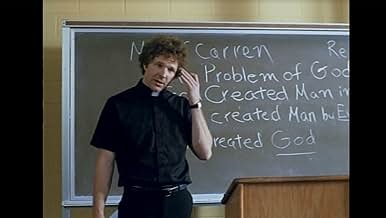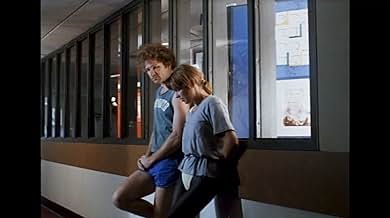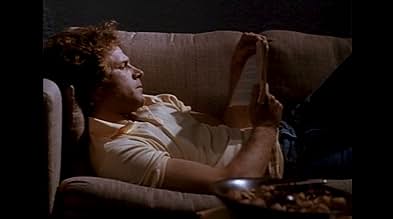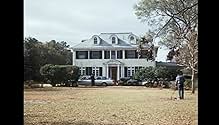Füge eine Handlung in deiner Sprache hinzuA student-teacher relationship goes way beyond the classroom, including pre-historic times.A student-teacher relationship goes way beyond the classroom, including pre-historic times.A student-teacher relationship goes way beyond the classroom, including pre-historic times.
Bobby Jacoby
- Basketball Player #3
- (as Robert Jacoby)
Empfohlene Bewertungen
Steer clear of this film, it was just a bad idea all away around. Sam Bottoms performance is laughable, he chews up dialogue more than the Cookie Monster. The story (or lack of) deteriorates into a fantasy film in which several characters go back to prehistoric time. Then its time to add some Playboy Playmates (the terrible "actress" Sherrie Rose for example) for mere eye candy. Just a dud overall.
My review was written in February 1989 after watching the movie on Academy video cassette.
Intriguing but disappointing, "After School" attempts to mix exploitation elements with the traditional morality tale. Pic received a modest regional release last year ahead of video.
Format of present-day moral crisis mirrored by intercutting with primitive man's behaviour thousands of years ago is a throwback to silent cinema, especially the work of Cecil B. DeMille. Confusion of content is reflected in pic's title changes, ranging from "Before God" and "Return to Eden" to distributor's racier "Private Tutor" and finally "After School".
Sam Bottoms toplines as a young priest teaching at St. Joseph's Catholic College in Florida who is selected to defend the faith on the Dick Cavett tv talk show against ex-priest Robert Lansing's book "Before God", which claims man created God in his own image.
While prepping for the debate, Bottoms falls in love with beautiful student Renee Coleman, whose own perceptive classroom questioning of church dogma adds to his doubts and ultimately forces Bottoms to go his own way, leaving Lansing victorious.
Pic's use of primitive man footage is a bit suspect, since it includes lots of topless scenes of beautiful cavewomen Alison Woodward, Jacqueline Rodriguez and Catherine Williams that are extraneous to the main action. Director William Olsen managed to juggle the commercial realities of exploitation filmmaking and thoughtful themes far more convincingly in his 1983 feature "Getting It On".
Bottoms is earnest in an old-fashioned style and the film drags on repetitively rather than developing its religious ideas. Coleman as his love interest is a fresh new actress worth watching (also seen to good effect as the kidnapped beauty in the recent release "Who's Harry Crumb?").
Tech credits are fine, with colorful lensing in the Orlando, Florida area.
Intriguing but disappointing, "After School" attempts to mix exploitation elements with the traditional morality tale. Pic received a modest regional release last year ahead of video.
Format of present-day moral crisis mirrored by intercutting with primitive man's behaviour thousands of years ago is a throwback to silent cinema, especially the work of Cecil B. DeMille. Confusion of content is reflected in pic's title changes, ranging from "Before God" and "Return to Eden" to distributor's racier "Private Tutor" and finally "After School".
Sam Bottoms toplines as a young priest teaching at St. Joseph's Catholic College in Florida who is selected to defend the faith on the Dick Cavett tv talk show against ex-priest Robert Lansing's book "Before God", which claims man created God in his own image.
While prepping for the debate, Bottoms falls in love with beautiful student Renee Coleman, whose own perceptive classroom questioning of church dogma adds to his doubts and ultimately forces Bottoms to go his own way, leaving Lansing victorious.
Pic's use of primitive man footage is a bit suspect, since it includes lots of topless scenes of beautiful cavewomen Alison Woodward, Jacqueline Rodriguez and Catherine Williams that are extraneous to the main action. Director William Olsen managed to juggle the commercial realities of exploitation filmmaking and thoughtful themes far more convincingly in his 1983 feature "Getting It On".
Bottoms is earnest in an old-fashioned style and the film drags on repetitively rather than developing its religious ideas. Coleman as his love interest is a fresh new actress worth watching (also seen to good effect as the kidnapped beauty in the recent release "Who's Harry Crumb?").
Tech credits are fine, with colorful lensing in the Orlando, Florida area.
As a viewing experience, "After School" isn't so much bizarre as inexplicable.
Sure, it's a fairly run-of-the-mill drama about a relationship between a priest and a college girl that threatens to become romantic, and this culminates with an actually fairly pointless debate the priest has with an atheist on the "Dick Cavett show" - with Cavett playing himself.
What's inexplicable is that throughout this tale, scenes of prehistoric people are intercut. Why? What was the point of that? I do not believe that these scenes really tell a story of their own. Why were they included?
It is true that for a brief second, the characters discuss evolution. Does that justify making half the movie "Quest for Fire-lite"?
Of course, the prehistoric people are all almost naked, and played by obvious models chosen for their looks. So it does add nudity. But couldn't they have worked some of that in, in the present day? You know, like every other movie with topless actresses? Why did they have to go back in time just to show some skin?
This is one of the most perplexing filmmaking decisions I have ever witnessed the result of.
Sure, it's a fairly run-of-the-mill drama about a relationship between a priest and a college girl that threatens to become romantic, and this culminates with an actually fairly pointless debate the priest has with an atheist on the "Dick Cavett show" - with Cavett playing himself.
What's inexplicable is that throughout this tale, scenes of prehistoric people are intercut. Why? What was the point of that? I do not believe that these scenes really tell a story of their own. Why were they included?
It is true that for a brief second, the characters discuss evolution. Does that justify making half the movie "Quest for Fire-lite"?
Of course, the prehistoric people are all almost naked, and played by obvious models chosen for their looks. So it does add nudity. But couldn't they have worked some of that in, in the present day? You know, like every other movie with topless actresses? Why did they have to go back in time just to show some skin?
This is one of the most perplexing filmmaking decisions I have ever witnessed the result of.
Set on a contemporary college campus with flashbacks to prehistoric times, this very odd film attempts to question the meaning of love, the nature of God, and the role of the church in establishing societal boundaries. It's also one of relatively few films to feature perennial 70s-80s TV talk show host Dick Cavett on the big screen. Cavett, who rarely shied away from controversial subjects, appears as himself. Sam Bottoms plays a young priest who teaches religion at a Florida Catholic college. A rising star within church hierarchy, Bottoms is selected to go on Cavett's show to defend traditional church teachings about God against an author (and ex-priest) who has written a book suggesting God was created within the human mind. Bottoms accepts the assignment, but at the same time begins to have his own doubts about his commitment to the priesthood. Despite his vow of celibacy, he finds himself increasingly infatuated with a beautiful young student (Renee Coleman) who makes a play for his affections. Coleman, whose role is part naive schoolgirl, part calculated seductress, seems to have little trouble getting under Bottoms' skin or challenging his orthodox beliefs. The priest becomes increasingly obsessed with her while at the same time trying to maintain a state of denial about their mutual sexual attraction. Many of the issues raised here are eternal, if hardly original, and I found the film reasonably entertaining. Least effective, I thought, were the repeated flashbacks to prehistoric times. While apparently intended to be symbolic about the origins of concepts of God, these scenes really didn't tell or add much to the otherwise contemporary story, in my opinion. If anything, they just seemed calculated to add more nudity to the film. This reminded me more of a classic drive-in B-movie from the golden days of exploitation in the 70s rather than one from the late 80s. Within that context I thought it was pretty good.
I thought this was supposed to be of those raunchy 80s comedies but it's not what I expected. I was thinking its a movie like Porkey's or that direction. Pretty dull and boring and with the before time scenes it felt like there's 2 movies going on.
Wusstest du schon
- WissenswertesFinal role for Edward Binns.
- PatzerWhen Father Michael McCarren crashes into September Lane's car on his motorcycle, there's no dent on the door. In the next scene where September gets out of her car to check on Father Michael, the car's door is damaged.
- Zitate
Cardinal Gurney: How's it going?
Monsignor Frank Barrett: [Watching television] These talk shows are stirring up some controversial issues.
- SoundtracksThe Magic Of Love
Music by David C. Williams
Words by Glen Relfsteck
Sung by Laura Martier
Top-Auswahl
Melde dich zum Bewerten an und greife auf die Watchlist für personalisierte Empfehlungen zu.
- How long is After School?Powered by Alexa
Details
Box Office
- Bruttoertrag in den USA und Kanada
- 3.967 $
- Weltweiter Bruttoertrag
- 3.967 $
- Laufzeit1 Stunde 29 Minuten
- Sound-Mix
Zu dieser Seite beitragen
Bearbeitung vorschlagen oder fehlenden Inhalt hinzufügen





























